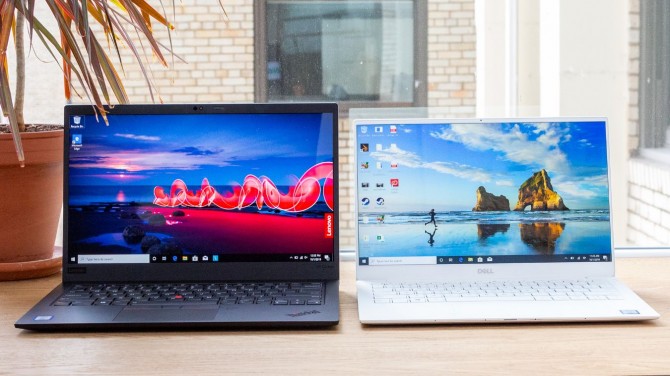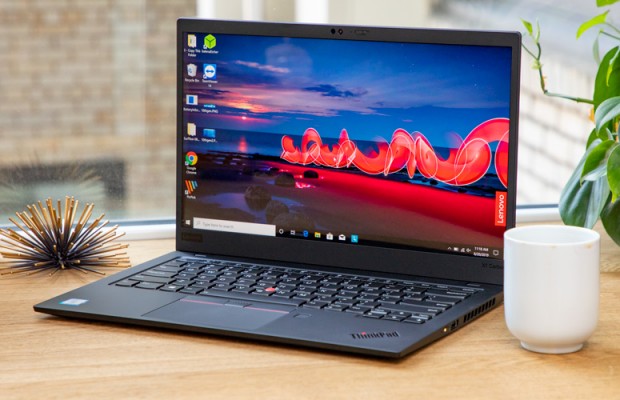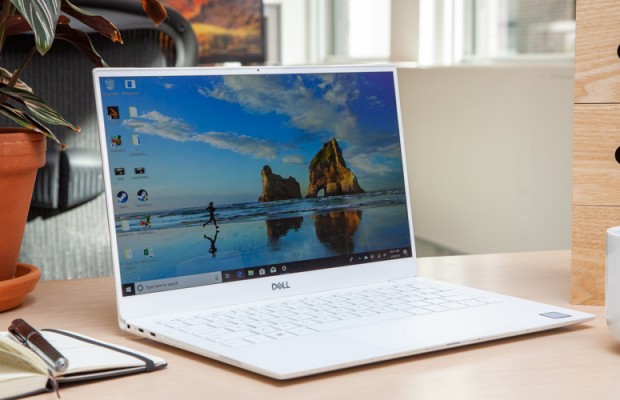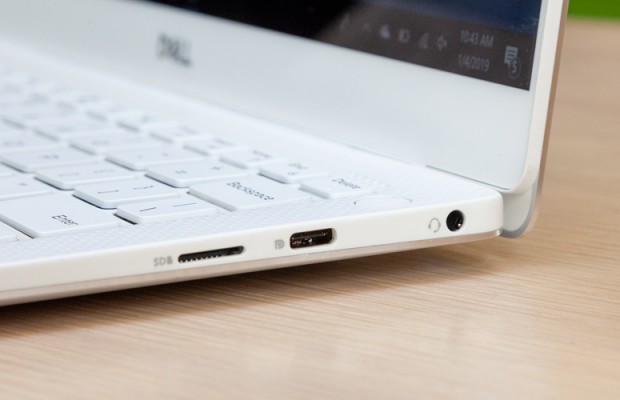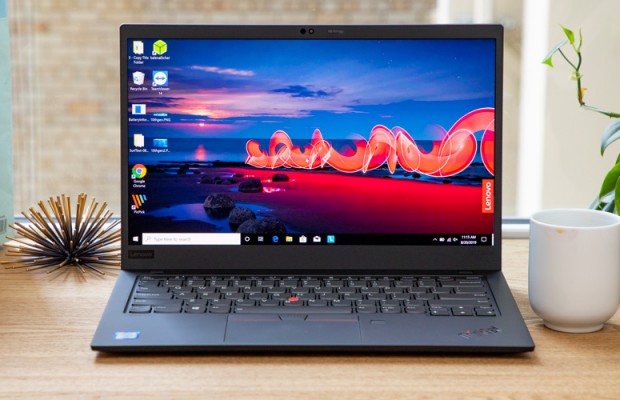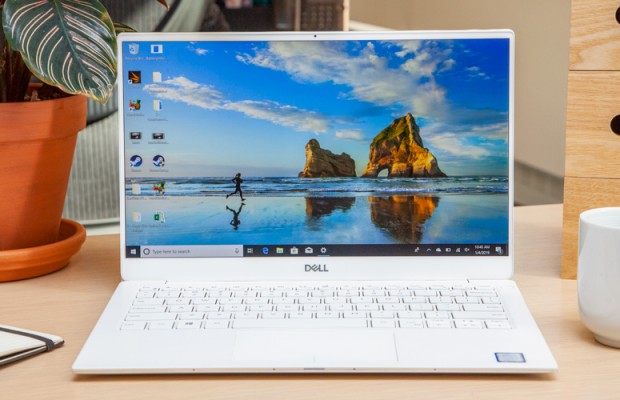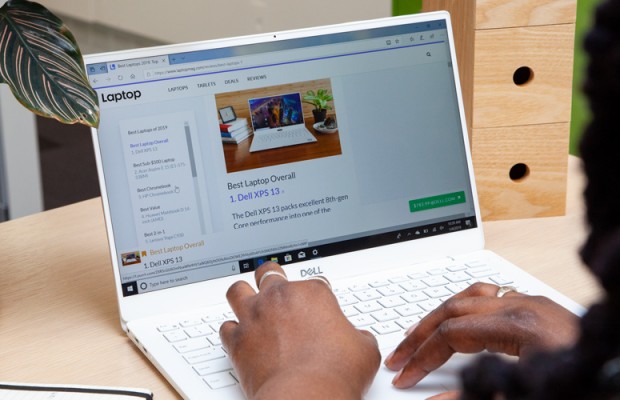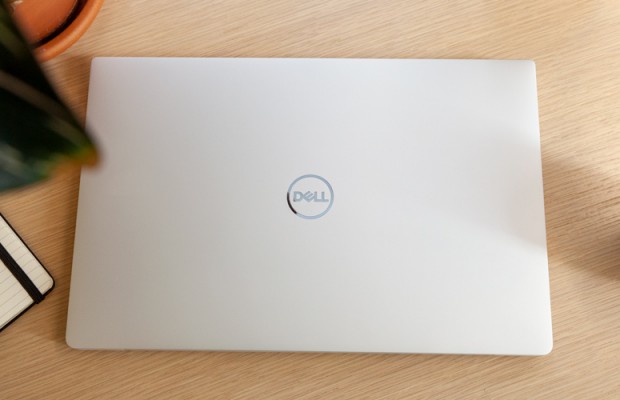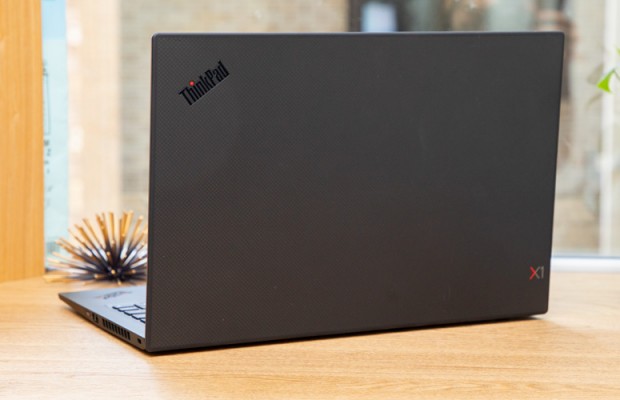Lenovo ThinkPad X1 Carbon vs Dell XPS 13: Which Premium Laptop Wins?
We've long considered the Dell XPS 13 the best laptop overall thanks to its long battery life, sleek design and fast performance. But if there's one notebook capable of knocking it from its perch it's Lenovo's ThinkPad X1 Carbon.
The successor of the 5-star-rated 2018 model, the 7th Gen X1 Carbon builds upon our favorite business laptop by adding two additional speakers, a stealthy carbon fiber pattern on the lid and a webcam cover. These improvements help the X1 Carbon retain its title as the best business laptop you can buy.
But do these subtle changes make the latest X1 Carbon better than the XPS 13, our current best overall laptop?
Here is how the ThinkPad X1 Carbon compares to the XPS 13.
Lenovo ThinkPad X1 Carbon vs Dell XPS 13: Specs Compared
| Lenovo ThinkPad X1 Carbon | Dell XPS 13 | |
| Price (Starting/as configured) | $1,463 ($2,562) | $899 ($2,449) |
| Colors | Black with red accents | Silver with black carbon fiber/Frost or Rose gold with arctic white |
| Display | 14-inch, 1080p or 4K | 13.3 inches, 1080p or 4K touch |
| CPU | Intel Core i5-8265U, Intel Core i7-8665U with vPro | Core i3-8145U, Core i5-8265U, Core i7-8565U |
| RAM | 8GB, 16GB | 4GB, 8GB, 16GB |
| SSD | 256GB, 512GB | 128GB, 256GB, 512GB, 1TB |
| Ports | 2 Thunderbolt 3, Ethernet dock, 2 USB 3.1 Type-A, HDMI, Kensington lock, headphone | 2 Thunderbolt 3, USB 3.1 Type-C, microSD, lock slot, headphone |
| Size | 12.7 x 8.6 x 0.6 inches | 11.9 x 7.8 x 0.5 inches |
| Geekbench | 16,597 | 14,936 |
| Battery Life (hrs:min) | 5:33 (4K), 9:30 (1080p) | 7:50 (4K), 12:22 (1080p) |
| Weight | 2.1 pounds | 2.7 pounds |
Design
The X1 Carbon and XPS 13 are two very different looking laptops but they're both gorgeous in their own right.
Sign up to receive The Snapshot, a free special dispatch from Laptop Mag, in your inbox.
Starting with Lenovo, the ThinkPad X1 Carbon retains its predecessor's slim and incredibly lightweight chassis. Despite its size, Lenovo gave the X1 Carbon all the features you would expect from a ThinkPad: military-grade durability, red accents that pop on a svelte black chassis, and a carbon-fiber lid.
Speaking of which, this year's X1 Carbon now has a carbon fiber weave pattern on the lid that accentuates its unique material.
The XPS 13 is undoubtedly the glitzier of the two laptops, especially the Arctic White version, which has a pristine glass-fiber weave on the deck and a light-gray aluminum lid with a pearlescent finish.
Around the XPS 13's display are razor-thin bezels, which keep the size of the laptop to a minimum while drawing your eyes toward the laptop's edge-to-edge display. And this year's model returns the webcam to where it belongs: above the display. The XPS 13 is also available in Rose Gold.
MORE: Best Lenovo Laptops
The XPS 13 (11.9 x 7.8 x 0.5 inches, 2.7 pounds) is a much more compact laptop, but we have to hand it to the ThinkPad X1 Carbon (12.7 x 8.6 x 0.6 inches, 2.1 pounds) for weighing so much less, despite having a larger, 14-inch display.
Winner: Draw
Ports
This round would have been a blowout if not for one notable omission on the ThinkPad X1 Carbon: an SD card slot.
Otherwise, the ThinkPad X1 Carbon offers a wider range of connections than the XPS 13, including two Thunderbolt 3 ports, an Ethernet dock, two USB 3.1 Type-A inputs, an HDMI, a Kensington lock and a headphone/mic jack.
Because of its tiny footprint, the XPS 13 can only fit two Thunderbolt 3 inputs, a USB Type-C port, a lock slot and a headphone jack. Content creators will also appreciate its microSD card slot.
Winner: ThinkPad X1 Carbon
Display
You can't go wrong with any of the display options offered on either laptop. If you want the absolute best panel, go with the X1 Carbon's 14-inch, 4K HDR display.
The picture on the ThinkPad X1 Carbon's 4K panel was significantly more saturated when I compared it side-by-side to the XPS 13's 13.3-inch, 4K display. In a trailer for Zombieland: Double Tap, Woody Harrelson's piercing blue eyes popped against his rosy cheeks on the X1 Carbon whereas those vivid colors were sapped on the XPS 13.
Both panels were extremely sharp but that extra screen real estate on the ThinkPad X1 Carbon makes it better for consuming media.
The differences between the 1080p panels on the XPS 13 and X1 Carbon are more subtle. When I watched a trailer for Terminator: Dark Fate, I noticed that the X1 Carbon's panel had a cleaner white balance where Dell's leaned slightly yellow. Both displays were sharp and equally vibrant.
Unsurprisingly, the ThinkPad X1 Carbon's 4K display covers 144% of the sRGB color gamut, making it more colorful than the XPS 13's 4K display (126%). The X1 Carbon is also brighter than the XPS 13 (375 nits), reaching a blinding 412 nits.
The 1080p display options on these laptops are much closer in quality, with the X1 Carbon's FHD screen (109%, 336 nits) being less vibrant and slightly dimmer than the XPS 13's (126%, 357 nits).
Winner: ThinkPad X1 Carbon
Keyboard and Touchpad
If the primary use of your laptop is to type reports, articles or emails, then buy the ThinkPad X1 Carbon. With one of the best keyboards we've used on any ultraportable laptop, the X1 Carbon is a typer's dream machine.
What makes its keyboard so good? For one, the gently curved keys have a surprising amount of travel considering the X1 Carbon has such a slim chassis. They are also quite clicky and require just the right amount of force to depress. And compared to the XPS 13, the ThinkPad X1 Carbon has larger keys with better spacing, which makes its keyboard more comfortable to use.
The XPS 13's keyboard isn't bad, per se. But the shallow, slightly cramped keys don't give it a chance against the X1 Carbon. On a positive note, the XPS 13's keys have a snappiness to them and are big enough to accommodate larger hands.
I fired up the 10FastFingers.com typing test and banged out 114 words per minute with an accuracy rate of 95% on the XPS 13. That's a good result, but not quite as fast or accurate as the 118-wpm with a 96% accuracy result that I nabbed on the ThinkPad X1 Carbon.
If you like discrete clickers, the X1 Carbon is right up your alley. Otherwise, the XPS 13 has the better touchpad (4.1 x 2.3 inches), which isn't just larger than the X1 Carbon's (3.9 x 2.2 inches) but also feels smoother.
Winner: ThinkPad X1 Carbon
Performance
Most folks won't have any problems with the performance of the ThinkPad X1 Carbon or XPS 13. These laptops performed similarly in our benchmark tests, so you probably won't notice a big speed difference between them.
The ThinkPad X1 Carbon with a Core i7-8665U CPU and 16GB of RAM achieved a 15,649 on the Geekbench 4 overall performance test, besting the XPS 13's (Core i7-8565U, 16GB of RAM) score of 14,946 and the category average (11,726).
The XPS 13 and its 1TB PCIe SSD rebounded on our hard drive test by duplicating 4.97GB of multimedia files in 9 seconds at a rate of 565 megabytes per second. That just edges out the 512GB M.2 PCIe NVMe Opal 2 SSD in the ThinkPad X1 Carbon, which completed the task at a rate of 508.9 MBps. The premium laptop average falls between those figures, at 515.5 MBps.
On the Handbrake video transcoding test, the ThinkPad X1 Carbon turned a 4K video into 1080p resolution in 17 minutes and 40 seconds while the XPS 13 needed 19 minutes and 20 seconds to finish the assignment.
Equipped with Intel UHD 620 graphics, neither laptop is really meant for gaming. You can still run lightweight games and graphics-heavy programs, as proven by the ThinkPad X1 Carbon's (86,473) and XPS 13's (88,473) 3DMark Ice Storm Unlimited scores, which fall only slightly short of the premium laptop average (90,978).
We also tested the Core i5 version of the ThinkPad X1 Carbon and the Core i3 version of the XPS 13 but didn't include them in this face-off because it wouldn't be an apples-to-apples comparison.
Winner: ThinkPad X1 Carbon
Battery Life
The Dell XPS 13's dominance in the battery life category continues.
Even the 4K version of the XPS 13, which lasted 7 hours and 50 minutes, did a decent job, outlasting the 4K ThinkPad X1 Carbon (5:33) by more than two hours.
The 1080p ThinkPad X1 Carbon did a much better job, with a runtime of 9 hours and 30 minutes. Still, it's no match for the 1080p XPS 13 and its outstanding 12 hours and 22-minute endurance, although it's worth noting that this model had an underpowered Core i3 CPU.
Winner: XPS 13
Value and Price
Time to start saving. Both of these flagship laptops cost a pretty penny but Dell at least offers cheaper, lower-end models of the XPS 13.
An XPS 13 with a 1080p display, Core i3 CPU, 4GB of RAM and a 128GB SSD goes for $899. We recommend staying away from that base model and spending $1,119 for a Core i5-8265U version with 8GB of RAM and a 256GB SSD.
You can also splurge on the $2,449 model we reviewed, which has a 4K touch screen and packs a Core i7-8565U CPU, 16GB of RAM and a 1TB PCIe SSD.
Our base ThinkPad X1 Carbon review unit comes with a 1080p display, a Core i5-8265U CPU, 8GB of RAM and a 256GB M.2 PCIe NVMe SSD, and costs $1,463, or around $300 more than a similarly-specced XPS 13.
For $1,697, you can upgrade to a Core i7-8565U CPU, 16GB of RAM and a 256GB SSD.
We also tested the 4K model of the X1 Carbon, which has a Core i7-8665U with vPro CPU, 16GB of RAM and a 512GB SSD. That model isn't available but a similar version with a 1TB SSD costs $2,562, or about $100 more than the XPS 13.
Winner: XPS 13
Overall Winner: ThinkPad X1 Carbon
There you have it. The X1 Carbon wins this dual by a razor's edge. The victory can be attributed to the ThinkPad X1 Carbon's wider range of ports, a more comfortable keyboard, slightly faster performance and a superior 4K display.
| Row 0 - Cell 0 | Lenovo ThinkPad X1 Carbon | Dell XPS 13 |
| Design (10) | 8 | 8 |
| Ports (10) | 8 | 6 |
| Display (15) | 14 | 13 |
| Keyboard/Touchpad (15) | 13 | 12 |
| Performance (20) | 19 | 18 |
| Battery Life (20) | 16 | 19 |
| Value (10) | 5 | 6 |
| Overall (100) | 83 | 82 |
But that doesn't mean the X1 Carbon is the best laptop for everyone. If battery life is a primary concern, then get the XPS 13. And while the XPS 13 is heavier than the Carbon, Dell's 13-inch laptop is much more compact. Then there's the price. Both of these laptops are expensive, but the XPS starts at a lower price and generally costs less than a similarly specced X1 Carbon.
The bottom line, though, is that you can't go wrong with either of these ultraportable, ultra-capable laptops.
Phillip Tracy is the assistant managing editor at Laptop Mag where he reviews laptops, phones and other gadgets while covering the latest industry news. After graduating with a journalism degree from the University of Texas at Austin, Phillip became a tech reporter at the Daily Dot. There, he wrote reviews for a range of gadgets and covered everything from social media trends to cybersecurity. Prior to that, he wrote for RCR Wireless News covering 5G and IoT. When he's not tinkering with devices, you can find Phillip playing video games, reading, traveling or watching soccer.
